May 16-23, 2001
Grand Island, N.Y.
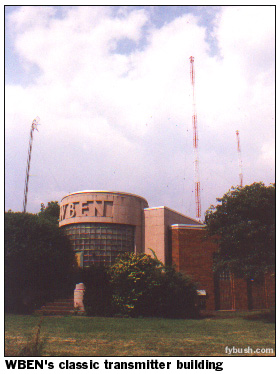 Drive
from Buffalo to Niagara Falls or from Rochester to Toronto, and
there's no avoiding Grand Island. The island, and the town by
the same name, sit right in the middle of the Niagara River just
a few miles south of the famous falls, linked to Niagara Falls
on one end and to Buffalo on the other by two bridges carrying
I-190 across. Drive
from Buffalo to Niagara Falls or from Rochester to Toronto, and
there's no avoiding Grand Island. The island, and the town by
the same name, sit right in the middle of the Niagara River just
a few miles south of the famous falls, linked to Niagara Falls
on one end and to Buffalo on the other by two bridges carrying
I-190 across.
For the average tourist, Grand Island offers little beyond
an old amusement park. For the discerning radio tourist, though,
the island offers a little something for any taste.
To the left, for instance, is one of the prettiest AM sites
in the Northeast. WBEN (930) was the first station on the island
when it moved to this site near the southern edge of Grand Island,
just a few miles north of downtown Buffalo.
During the day, WBEN's nondirectional signal is widely heard
in western New York and southern Ontario, thanks in part to the
water path from this site to just about anywhere in the region.
At night, WBEN goes directional from these two towers, aiming
mostly south into Buffalo and north to Niagara Falls and Toronto.
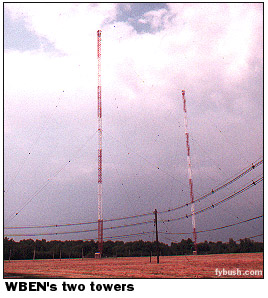 When your editor
took these pictures in the summer of 1996, on a whirlwind one-day
tour of almost every site in the Buffalo market (thanks, Greg
and George!), one feature of the site that drew comment was the
old five-wire transmission line out to the towers. Is it still
in use now, or just a visible relic of the old days? We don't
know. When your editor
took these pictures in the summer of 1996, on a whirlwind one-day
tour of almost every site in the Buffalo market (thanks, Greg
and George!), one feature of the site that drew comment was the
old five-wire transmission line out to the towers. Is it still
in use now, or just a visible relic of the old days? We don't
know.
The STL dish seen above was then pointed south, at the building
a few miles south of the bridge that had been home to WBEN AM-FM-TV
since 1960. Since then, the TV station (now known as WIVB) has
become the sole occupant of 2077 Elmwood Avenue, and the radio
stations now broadcast from a new studio complex in Amherst.
Next on the island, and a few miles north of the WBEN site,
is the only facility on Grand Island not licensed to Buffalo.
WHLD (1270) is a Niagara Falls station in name at least, though
it's been based in Erie County for decades. For most of that
time, its ethnic programming came from a little white building
at 2692 Staley Road on Grand Island. Your editor remembers visiting
there in the early nineties, when a big neon sign in the window
proudly proclaimed WHLD's presence there.
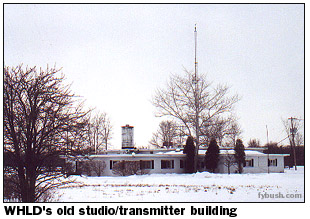 Since then, WHLD
has pulled up stakes and moved on to bigger things. The studios
left a few years ago, moving south to downtown Buffalo. And since
last year, the two WHLD towers have been silent on AM, with the
1270 signal now diplexed from the five towers of WNED (970),
far to the south of Buffalo in Hamburg. Since then, WHLD
has pulled up stakes and moved on to bigger things. The studios
left a few years ago, moving south to downtown Buffalo. And since
last year, the two WHLD towers have been silent on AM, with the
1270 signal now diplexed from the five towers of WNED (970),
far to the south of Buffalo in Hamburg.
WHLD was always a directional signal, hemmed in to the east,
west and south. Pointing north from Grand Island gave it fine
coverage in Niagara Falls; by moving to Hamburg, that northern
beam now takes in Buffalo and its many ethnic neighborhoods as
well. (And by day at least, the 5000 watts still sound just fine
in the Falls; nights are another matter with just 122 watts!)
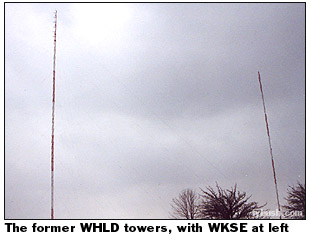 So why are these
towers still standing? There's another occupant that's not going
anywhere. WKSE (98.5) is Niagara Falls' lone FM station, descendant
of the old WHLD-FM by way of WZIR ("The Wizard") and
WRXT in the eighties. So why are these
towers still standing? There's another occupant that's not going
anywhere. WKSE (98.5) is Niagara Falls' lone FM station, descendant
of the old WHLD-FM by way of WZIR ("The Wizard") and
WRXT in the eighties.
Now known as "Kiss," it's a Buffalo station in all
but license. The studios moved to Buffalo when WKSE became a
sister station to WWKB (1520) in the mid-eighties, and are now
in Amherst at that same Entercom complex as WBEN. (As we'll soon
see, there are historical links binding all of these Grand Island
sites.)
But you can't really see WKSE from the 190 as you speed across
Grand Island, and you can only make out WBEN if you look to the
west at just the right moment. What catches your eye from a distance,
instead, are the TV sites east of the highway on Whitehaven Road.
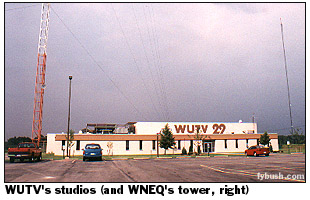 WUTV (Channel 29)
was here first, launching as Buffalo's first independent station
in 1970 from the same site it occupies to this day. Why Grand
Island instead of the existing VHF towers in the hills south
of Buffalo? Here's my theory: WUTV's independent fare was as
welcome in Toronto's three-station environment as it was in Buffalo.
UHF receivers of the day were far less sensitive than they are
now, so by locating 30 miles closer to Toronto on Grand Island,
WUTV could better serve that lucrative Canadian audience, something
it still does to this day (though largely via cable coverage,
which now takes the WUTV signal east to Ottawa, west to London
and nationwide by satellite). WUTV (Channel 29)
was here first, launching as Buffalo's first independent station
in 1970 from the same site it occupies to this day. Why Grand
Island instead of the existing VHF towers in the hills south
of Buffalo? Here's my theory: WUTV's independent fare was as
welcome in Toronto's three-station environment as it was in Buffalo.
UHF receivers of the day were far less sensitive than they are
now, so by locating 30 miles closer to Toronto on Grand Island,
WUTV could better serve that lucrative Canadian audience, something
it still does to this day (though largely via cable coverage,
which now takes the WUTV signal east to Ottawa, west to London
and nationwide by satellite).
A similar motivation might have insipired Buffalo's public
TV station, WNED-TV (Channel 17), to make its own move to Whitehaven
Road in the eighties. WNED was the descendant of WBUF-TV, one
of NBC's early experiments in owned-and-operated UHF stations.
When WBUF-TV went dark in 1959, the facilities were donated to
public broadcasting, and for the next two decades or so, WNED-TV
used the studios and tower at 184 Barton Ave. that had been WBUF's.
Moving to its own tall tower on Grand Island greatly improved
the Channel 17 signal, especially into Canada - and WNED now
identifies as "Buffalo-Toronto."
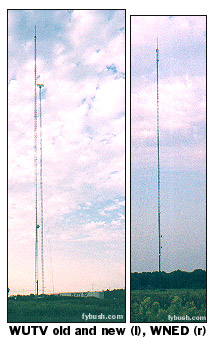 WNED
added a second signal after moving to Grand Island. WNEQ (Channel
23) debuted in 1987 from an antenna side-mounted on the channel
17 tower and enjoyed a little over a decade as a public broadcaster
before being put up for sale in the late nineties. WNED
added a second signal after moving to Grand Island. WNEQ (Channel
23) debuted in 1987 from an antenna side-mounted on the channel
17 tower and enjoyed a little over a decade as a public broadcaster
before being put up for sale in the late nineties.
Sinclair, whch owned WUTV, was the initial prospective buyer,
and it was perhaps with channel 23 in mind that the station built
a new tower in the late nineties next to its existing 1970 stick.
While it appears shorter in the photo to the left, the new stick
is in fact a bit taller; it's just deeper back on the property
than the old tower.
Sinclair never bought WNEQ, though it at least now has plenty
of tower space for the DTV conversion at WUTV (once the international
treaties are finalized to clear the way for DTV in our area,
that is).
Sinclair also never built its planned studio complex in downtown
Buffalo, which would have housed the TV stations and the radio
group it then owned, including WBEN and WKSE. The radio stations
were later sold to Entercom, and WUTV stayed put on Whitehaven
Road. (WUTV also holds the curious honor of being the largest-market
Fox affiliate with no local news, another nod perhaps to its
large Canadian audience.)
Channel 23, meanwhile, did finally get sold. In early 2001,
it relaunched as commercial independent WNLO, a sister to CBS
affiliate WIVB. It remains on the WNED tower, though -- and therein
lies the last thread of the connections that weave among all
these sticks. For WNLO's studios, with WIVB at 2077 Elmwood Avenue,
are not just the former home of WBEN (which in turn became a
sister to WKSE and WUTV later on). You see, that building was
originally built in the late 1950s by NBC, as the future home
of WBUF-TV...channel 17.
And if I were a certain well-known veteran radio commentator,
I'd say you now know...well, it's his phrase, not mine. Instead,
I'll simply invite you back in a week for a trip all the way
to the eastern end of NERW-land. See you then!
|
